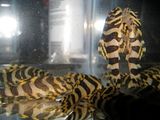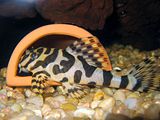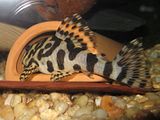Page 1 of 1
L134, Male or Female?
Posted: 24 Feb 2010, 13:21
by ducky
What do you think? Fat male or hairy female??

Re: L134, Male or Female?
Posted: 24 Feb 2010, 13:24
by MatsP
I would think fat male. But I'm far from certain. I feel these aren't easy to sex. The pectoral fins are also not very hairy, which is more typical for females.
--
Mats
Re: L134, Male or Female?
Posted: 24 Feb 2010, 15:45
by hotplecogirl
i have a group of these.When i first got them i guessed which was what.Later they have bred and i was not very accurate with my guesses.I think that one is a girl.
Re: L134, Male or Female?
Posted: 24 Feb 2010, 16:12
by drpleco
It would be pretty rare to find a female that hairy but very common to find a male that fat. Peckoltias get fat and you can't sex them by body shape like hypans.
Re: L134, Male or Female?
Posted: 26 Feb 2010, 03:44
by ducky
i only feed them once everynight but all of them are quite fat. will try to take picture of others when i redo my setup.
Re: L134, Male or Female?
Posted: 15 Mar 2010, 14:41
by ducky
Re: L134, Male or Female?
Posted: 15 Mar 2010, 18:14
by Richard B
is it me or does fish 9 look completely different to the other?
Re: L134, Male or Female?
Posted: 16 Mar 2010, 00:44
by apistomaster
I have trouble sexing L134's, myself.
I use methods which are too subjective to be discussed as facts just as I do when trying to choose which wild Discus I am going to set up as pairs.
I use body shapes differences and behavioral difference then try different combinations until I find which ones work. Not very helpful, I know.
Males do tend to glom on to the best caves; preferably using fewer caves than I think I have in possible males. Those tend to be the dominant males. The females tend to use other available cover like hiding under wood or underneath pedestal type sponge filters.
Since I only need 2 males to service 4 females I can use a process of elimination to remove excess males which constantly challenge the dominant males for the few caves available. When 2 adults spend time together in a cave it is usually a pair.
Unless all the fish are the same age and condition it is difficult to tell a at male outside of breeding condition from a fat female in breeding condition. I haven't noticed any females that have odontodes as prominent as some of the fish in the photos so I would consider those to be males unless they prove me wrong by laying eggs.
I wonder if among adult wild fish if the sex ratios aren't skewed in favor of the males which may have been more reluctant to abandon their natural hiding spot during collection. Spots like this that provide the best combination of cover, food and defensible territory are called "prime lies" in trout fly fishing parlance. I think the more free roaming females tend to make more successful dashes to deeper water when frightened by collecting activities but that is merely a personal hypothesis. I always try to begin with as many specimens as I can obtain and house to allow for the removal of surplus males yet still end up with a breeding group. My target is normally 2 males and 4 females set up in a 20 Long.
Wild Discus are very difficult to sex but there are some very slight differences in morphology between the sexes. I choose 2 which seem to be a male and female and add a 3rd fish to see if the pairs align differently than my first assumptions. 2 Males will fight over a female and the female of a pair will always try to stay between her chosen male and the interloping female. 2 females will also fight but when they do they take on a color that is characteristic of females wanting to spawn which is different than that of breeding males. I just used this process of educated guess combined with a process of elimination to set up 3 pairs of Alenquer Discus. I do enjoy my catfish but I have been involved much longer and deeper with keeping and breeding Discus. I use different methods for wild Discus than I do for domestic Discus because the domestics are very easy to sex and breed compared with the wild fish.
The bottom line is that it is the sum of experience which will help increase your estimations accuracy but the final proof is always a fertile spawn.
Re: L134, Male or Female?
Posted: 16 Mar 2010, 01:05
by Suckermouth
Richard B wrote:is it me or does fish 9 look completely different to the other?
I'm actually kind of curious why there are more spotty L134 and more stripey L134, in general, not just in this batch.
Re: L134, Male or Female?
Posted: 16 Mar 2010, 01:42
by apistomaster
There are some populations of L134 which have very few stripes and spots. They are mostly a bright yellow.
Re: L134, Male or Female?
Posted: 16 Mar 2010, 02:18
by dconnors
Some of those look like they could be the 'Rio Jamanxim' sub species.

Side pics would be very nice.

Re: L134, Male or Female?
Posted: 16 Mar 2010, 13:57
by plec0
i say 5 males/ 5 females.. but thats just opinion, i guessed at my 134s and set them up accordingly into 3 tanks as 1m/2f, ended up being 2m/1f per setup.. so i eliminated a male per tank kept it 1m/1f then put them all back into 1 tank together with no problems, keep in mind, my females cave alot just like males, so caving has nothing to do with sex. My females some are hairy some are not, aI got a mixture of spotted 134s and striped, to me the tripses vs spots is something to do with ages as all my fry are striped vs adults being spotted, i do have a mature adult only 2 1/2 yrs old that is striped still and i believe over time they change their pattern.. i may be wrong, im not sure, but most of my adult older 134s ive had for 3 yrs and bought as wild caught already 3 inches were spotted when they came in.so they have to be atleast 5+ yrs old.
Re: L134, Male or Female?
Posted: 16 Mar 2010, 15:46
by YSR50
Richard B wrote:is it me or does fish 9 look completely different to the other?
younger fish is all. below are some clickable thumbnail
They all start out identical


as they get larger their lines begin to split and break apart

here you can see how the "3" pattern has changed in a few months


All of my frogs will cave, even the juvies. I'll agree with what's been said here, being as hairy as some of your pictures are I would say they are males. I keep 10 adults (+ some juvies and fry that escape my clutches) in a standard 55g. I have at least 2 pair in this tank breeding.



























